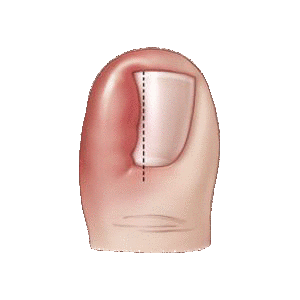
Ingrown Toenails
Ingrown Toenails
Ingrown nails are nails whose corners or sides dig painfully into the skin, often causing infection. They are frequently caused by improper nail trimming, but also by shoe pressure, injury, fungus infection, heredity, and poor foot structure. Toenails should be trimmed straight across, slightly longer than the end of the toe, with toenail clippers.
Infected ingrown toenails rarely resolve on their own. Having the ingrown piece of nail removed usually resolves the pain and infection quickly -- most people who have their ingrown nail treated at their podiatrist's or family doctor's office will relate that the pain subsided a few hours after treatment and that the infection improved in a few days. In some cases, although infrequently, a long-standing infected ingrown toenail can spread to the toe bone beneath the nail -- this is why it's important to not let the infection linger and to seek prompt medical care.
If you have a painful or infected toenail, contact our office. We may remove the ingrown portion of the nail and if the condition reoccurs frequently, we may permanently remove the nail.



Hover Over
(Ingrown Toenail Post Surgery Healing)
*Dramatic Example for illustrative purposes. Typically a smaller portion of the nail will have to be removed.
Ingrown toenail symptoms include:
-
Redness surrounding the toenail
-
Swelling of your toe around the nail
-
Infection (sensitivity) of the tissue around your toenail
-
Pain/tenderness in your toe along one or both sides of the nail
When to see a doctor
-
Experience discomfort in your toe
-
See Pus (infection) or redness
-
Have diabetes
-
Have another condition that causes poor blood flow to your feet
Causes
Common ingrown toenail causes include:
-
Improperly sized shoes
-
Improperly cutting/trimming of the toenail (too short on sides)
-
An injury
-
Growth issues
Left untreated or undetected, an ingrown toenail can infect the underlying bone and lead to a serious bone infection.

.png)
.png)





